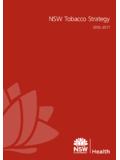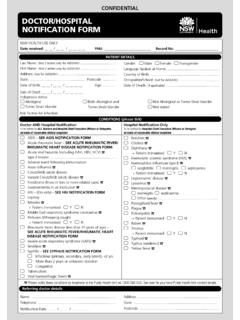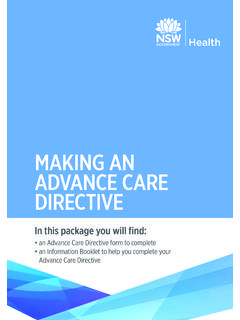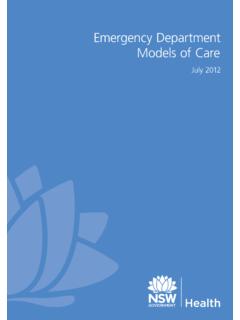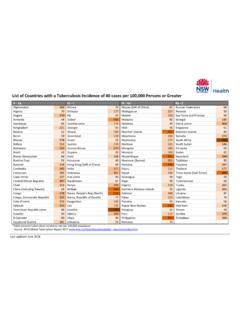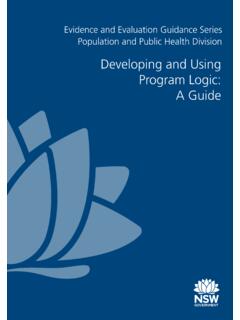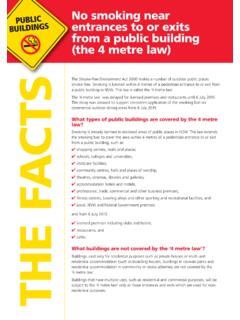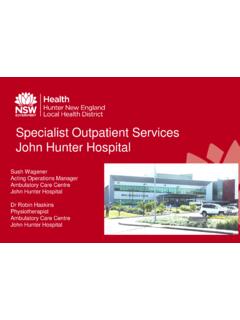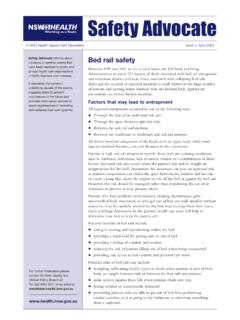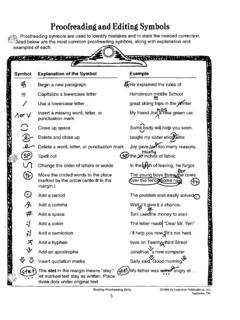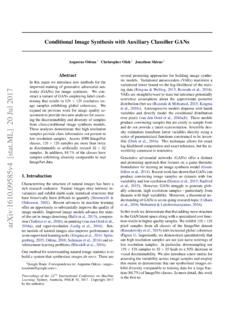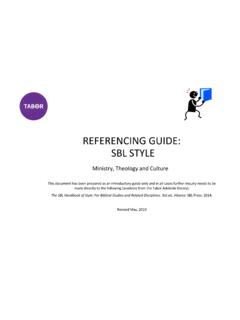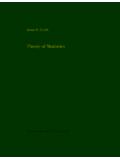Transcription of GUIDE TO POISONS AND THERAPEUTIC GOODS …
1 GUIDE TO POISONS AND THERAPEUTIC GOODS LEGISLATION FOR PHARMACISTS This GUIDE is a summary only, and should be used in conjunction with the POISONS and THERAPEUTIC GOODS Act 1966 and the POISONS and THERAPEUTIC GOODS Regulation 2008 (obtainable from Fuji Xerox, Tel. (02) 9311 9899; also available on the Internet at ) and the NSW POISONS List. Further information may be obtained from the Duty Pharmaceutical Officer, Pharmaceutical Services, Legal and Regulatory Services Branch, NSW Ministry of Health, Locked Mail Bag 961 North Sydney NSW 2059, Tel. (02) 9391 9944, Fax. (02) 9424 5860 or by email: NOTE: Wherever the term authorised practitioner is used in this GUIDE (other than in relation to Schedule 8 drugs), unless otherwise indicated, it refers to medical practitioners, dentists, veterinary practitioners, nurse and midwife practitioners authorised under section 17A of the POISONS and THERAPEUTIC GOODS Act, optometrists authorised under section 17B of the POISONS and THERAPEUTIC GOODS Act, and podiatrists authorised under section 17C of the POISONS and THERAPEUTIC GOODS Act.
2 1 THE POISONS LIST The POISONS List is the list of substances to which the POISONS and THERAPEUTIC GOODS Act and Regulation apply. It consists of eight schedules (Schedule 1 is empty, so reference to it has been omitted). The schedules align closely with those shown in the publication, Standard for the Uniform Scheduling of Medicines and POISONS (SUSMP), published by the Commonwealth under the THERAPEUTIC GOODS Act 1989 (available at: ). Following is a summary of the nature of the substances in each schedule. The requirements for the storage, supply, labelling, recording etc for Schedules 2, 3, 4 and 8 are detailed later in this GUIDE . Schedule 2 Substances which are dangerous to life if misused or carelessly handled, but which should be available to the public for THERAPEUTIC use or other purposes without undue restriction.
3 Schedule 3 Substances which are for THERAPEUTIC use and: i. about which personal advice may be required by the user in respect of their dosage, frequency of administration and general toxicity, ii. with which excessive unsupervised medication is unlikely; or iii. which may be required for use urgently so that their supply only on the prescription of an authorised practitioner would be likely to cause hardship. TG79/32 Issue date: June 2015 Page 1 of 26 Schedule 4 (Restricted Substances) Substances which in the public interest should be supplied only by, or upon the written prescription of, an authorised practitioner. Schedule 5 Poisonous substances of a dangerous nature commonly used for domestic purposes which should be readily available to the public but which require caution in their handling, use and storage.
4 Schedule 6 Substances which should be readily available to the public for agricultural, pastoral, horticultural, veterinary, photographic or industrial purposes or for the destruction of pests. Schedule 7 Substances of exceptional danger which require special precautions in their manufacture, packaging, storage and use. Schedule 8 (Drugs of Addiction) Substances which are addiction producing or potentially addiction producing. Possession, supply, prescribing and use are strictly limited. Other Controls Provision is also made for individual substances to be rigidly controlled by subjecting their use or supply to special authority. IMPORTANT NOTE: It is illegal for pharmacists (including members of their staff) to supply any scheduled substance (on prescription or otherwise) for THERAPEUTIC use in a quantity or for a purpose not in accordance with recognised THERAPEUTIC standards of what is medically appropriate in the circumstances.
5 Similarly, where the scheduled poison is not for THERAPEUTIC use, it may be sold only for either the purpose stated on the label or its normal use. Penalties apply. 2 SCHEDULE 2 Sale Retail sale only by authorised practitioners, pharmacists and persons licensed as POISONS sellers (country stores remote from a pharmacy). Wholesale sale of THERAPEUTIC substances may be made only by persons licensed or authorised to do so under the POISONS and THERAPEUTIC GOODS Regulation. Storage Must be kept apart from food. TG79/32 Issue date: June 2015 Page 2 of 26 3 SCHEDULE 3 Sale Retail sale only by authorised practitioners and pharmacists, including pharmacy interns working under the direct personal supervision of a pharmacist. Where a sale is made from a pharmacy other than on prescription, the pharmacist must personally hand the substance to the person and give the person the opportunity to seek advice as to the use, dosage and possible toxicity of the substance.
6 The latter does not apply in the case of: a) the supply of salbutamol or terbutaline in metered aerosols to a person holding an approved current asthma management certificate for use by them in emergency asthma management, or b) the supply of adrenaline to a certificated first-aider in single use automatic injectors delivering of adrenaline for anaphylaxis first aid. (see also Recordable Substances below). Wholesale sale of THERAPEUTIC substances may be made only by persons licensed or authorised to do so under the POISONS and THERAPEUTIC GOODS Regulation. Storage Must be kept genuinely out of public access in the dispensary or storeroom or in cabinets which are kept locked when not in immediate use. It is the pharmacist's responsibility to ensure that this is done.
7 Labelling The product must be labelled with the name and address of the pharmacy if not supplied and fully labelled as a dispensed medicine. Recordable Substances Additional requirements apply to the following substance; pseudoephedrine when included in Schedule 3. A record of the following details of each supply must be made in an approved recording system (refer to TG 50 in Further Information on the last page of this GUIDE ): name and address of patient (or if for animal use, the name and address of the animal's owner); name, strength and quantity of the substance; date of supply; name of the pharmacist who supplied the substance; a unique reference number (from approved recording system). TG79/32 Issue date: June 2015 Page 3 of 26 4 SCHEDULE 4 Sale Retail sale by authorised practitioners and by pharmacists on the prescription of such a practitioner.
8 Wholesale sale may be made only by persons licensed or authorised to do so under the POISONS and THERAPEUTIC GOODS Regulation. Storage Must be kept in the dispensary or other area to which customers do not have access. It is the pharmacist's responsibility to ensure that this is done. Prescription Must include the following particulars in ink in the prescriber's legible handwriting: (a) the date on which it is issued; (b) the patient's name and address (or, if for animal treatment, the owner s name and address and species of animal); (c) the name, strength and quantity of the restricted substance; (d) the number of repeats if the prescription is to be dispensed more than once (some prescriptions require repeat intervals see additional requirements below); (e) adequate directions for use; and (f) the prescriber's signature.
9 Additional requirements apply to prescriptions for specified barbiturates and anabolic/androgenic steroidal agents (see section ). Where the prescription is computer-generated (see TG 184 in Further Information in section 14), only the signature needs to be in the prescriber s handwriting. Prescription must also include: (a) name of prescriber (as registered to practice in Australia) and designation; (b) the address and telephone number of the premises at which the prescription is issued or, if issued at a hospital, the name, address and telephone number of the hospital; (c) if written by a dentist, the words, "For dental treatment only"; (d) if written by a veterinary practitioner, the words, "For animal treatment only"; (e) if written by an optometrist, the words For optometrical treatment only.
10 Where, in an emergency, instruction by telephone, electronic mail or facsimile is given to a pharmacist to supply a restricted substance, a prescription must be written in confirmation forthwith, endorsed as such, and forwarded to the dispensing pharmacist within 24 hours. If not received within 7 days the dispensing pharmacist must report this to Pharmaceutical Services (Tel. (02) 9391 9944). Care must be taken to avoid fraudulent use of this provision. TG79/32 Issue date: June 2015 Page 4 of 26 Dispensing A prescription for a restricted substance may NOT be dispensed if: (a) it is not correctly written as indicated above; (b) it is more than 12 months old (6 months if the drug is listed in Appendix D to the Regulation see Appendix D Substances in section ; (c) it is marked "cancelled" or all of the repeats have been dispensed; (d) where an interval for repeat is shown, the prescription is presented for dispensing at a shorter interval.)
